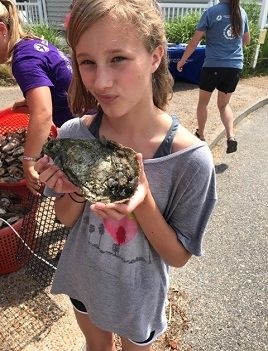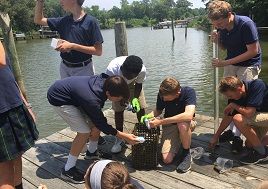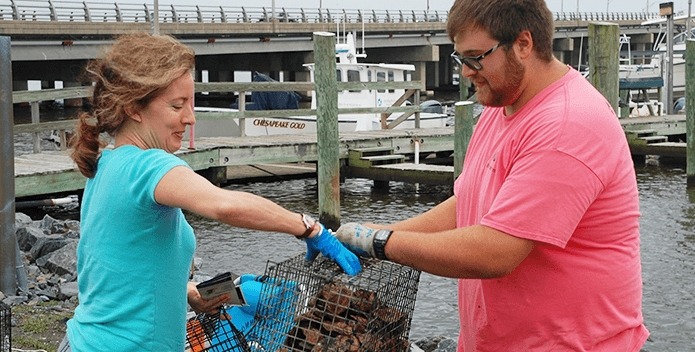Robin Blake began oyster gardening for the Chesapeake Bay Foundation five years ago in Irvington, Virginia. Since then, the science teacher at Chesapeake Academy has expanded her garden into two areas of Carter’s Creek, a tributary of the Rappahannock River. The oysters she raises from baby to adult are planted on a Virginia sanctuary reef to restore the wild population.

Eloise Caudle holds one of her own oysters.
Stephen Caudle
Nearby in Lancaster, Stephen Caudle and his daughter Eloise, now 14, have also been oyster gardening for five years. They got into it to give back to the Rappahannock, where they love boating, swimming, and exploring. “It is important to do our part,” Caudle said. “We enjoy the river so much.”
Oysters in Virginia have been decimated by years of disease and pollution, but are slowly staging a comeback thanks in part to restoration efforts. Oyster gardening gives volunteers the opportunity to play a role in bringing back this beloved bivalve.
The Chesapeake Bay Foundation is holding seminars in Deltaville, Lancaster, and Colonial Beach this summer to teach new growers the ropes. There each gardener receives two wire cages a bit larger than a shoe box to hang in the water off a dock or bulkhead. One is filled with spat about the size of your pinky nail. These grow rapidly in the rich waters of local rivers and creeks. Once they’ve outgrown the first cage they are then split between the two cages.

Chesapeake Academy seventh-graders clean their oysters from their oyster garden.
Robin Blake
As a teacher, Blake is always looking for new opportunities to show her students how to be ecologically minded. She and her students check the oysters regularly, and even test the water quality to make sure it is safe for the oysters.
Over time, the oyster-filled cages become homes to all sorts of critters, re-creating the habitat offered by wild oyster reefs. The crevices between the shells are hiding spots for many small creatures. Tiny crabs, shrimp, toadfish, and gobies make themselves at home. Blake’s students love finding all the little sea creatures that are attracted to their clumps of oysters.
The oysters in these cages spawn as they mature, increasing the local population. At the same time, they play an important role cleaning the water by feeding on algae and other particles from the water. A single adult oyster can filter up to 50 gallons of water per day.
After a year, gardeners part with their adult oysters to be planted in sanctuary reefs off-limits to harvest. The gardeners then receive a new set of baby oysters to repeat the cycle.
Blake said she is an oyster gardener to ensure clean water in the Bay. “We live on the water,” she said, “so it makes sense to take care of the water.”
Those interested in participating can visit one of several oyster gardening seminars this summer. That includes on June 15 at 9 a.m., at Doziers Marina & Yachting Center in Deltaville; on July 30 at 6 p.m., at the Potomac River Fisheries Commission in Colonial Beach; and on July 27 at 9 a.m., at Belle Isle State Park in Lancaster. New oyster gardeners can complete registration ahead of time at www.cbf.org/vaoystergardening. A $25 fee helps offset the cost of the program.
Wyatt Young, Chesapeake Bay Foundation Virginia Communications Intern



